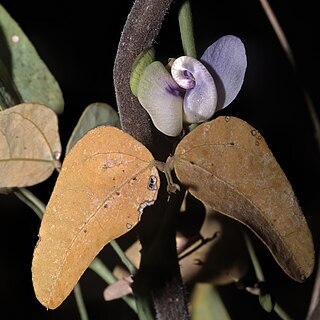Perennial twining herb. Stems rather slender, somewhat ridged, mostly glabrous, up to c. 3 m long; flowering shoots often leafless. Leaflets 2.2-7.5 x 0.8-3.7 cm, the terminal leaflet rhombic-lanceolate to triangular-ovate, the lateral leaflets similar but markedly asymmetrical, falcate; all leaflets narrowed to a rounded but mucronulate apex, or slightly emarginate, more rarely sharply acute, rounded at the base, with sparse short bristly hairs scattered on upper and lower surfaces and the margins, or glabrescent or more rarely densely pubescent, venation reticulate and prominent on both surfaces; petiole 2-6.5 cm long; rhachis 0.4-1.6 cm long; petiolules c. 2.5 mm long; stipules c. 3 mm long, narrowly ovate-elliptic. Inflorescence axis often much wrinkled, 0.4-1.5 cm long, often 2-3-branched or sometimes peduncle 3-4 cm long; pedicels 0.6-1.4 cm long; bracts and bracteoles minute, c. 1 mm long, ovate, ribbed, ciliate. Calyx tube 3-4 mm long, glabrous; lobes c. 2 mm long, deltate, ciliate, the upper pair united into a low rounded lip. Standard blue, greenish-yellow or mostly mauve, 1.5 x 1.8 cm; wings violet or pink; keel mostly pale. Hairs in a ring around stigma, clearly branched. Pods 7.5-12.5 cm × 5 mm, linear, curved at the tip, glabrous. Seeds dark blackish-red or brown mottled black, 5.5-8 x 3-4 x 2.5-3.2 mm, somewhat keeled along the distil margin, hollowed around the hilum.
Leaflets 2.2–7.5 × 0.8–3.7 cm, the terminal leaflet rhombic-lanceolate to triangular-ovate, the lateral leaflets similar but markedly asymmetrical, falcate; all leaflets narrowed to a rounded but mucronulate apex, or slightly emarginate, more rarely sharply acute, rounded at the base, with sparse short bristly hairs scattered on upper and lower surfaces and the margins, or glabrescent or more rarely densely pubescent, venation reticulate and prominent on both surfaces; petiole 2–6.5 cm long; rhachis 0.4–1.6 cm long; petiolules c. 2.5 mm long; stipules c. 3 mm long, narrowly ovate-elliptic.
A twining herb. It keeps growing from year to year. It climbs up to 3 m tall. The stems are slender. It grows from a large tuber. The leaves are compound. The leaves have 3 leaflets. They have leaflets along the stalk and one at the end. The leaves are broadly triangle shaped. They are 7.5 cm long by 3.5 cm wide. The flowers appear before the leaves. They are blue or pink. They are like pea flowers. They have a light yellow twisted keel. The fruit is a pod. It is narrow and 8-12 cm long by 5 mm wide. It is curved at the tip. It has a pointed beak.
Inflorescence axis often much wrinkled, 0.4–1.5 cm long, often 2–3-branched or sometimes peduncle 3–4 cm long; pedicels 0.6–1.4 cm long; bracts and bracteoles minute, c. 1 mm long, ovate, ribbed, ciliate.
Seeds dark blackish-red or brown mottled black, 5.5–8 × 3–4 × 2.5–3.2 mm, somewhat keeled along the distil margin, hollowed around the hilum.
Calyx tube 3–4 mm long, glabrous; lobes c. 2 mm long, deltate, ciliate, the upper pair united into a low rounded lip.
Stems rather slender, somewhat ridged, mostly glabrous, up to c. 3 m long; flowering shoots often leafless.
Standard blue, greenish-yellow or mostly mauve, 1.5 × 1.8 cm; wings violet or pink; keel mostly pale.
Pods 7.5–12.5 cm × 5 mm, linear, curved at the tip, glabrous.
Hairs in a ring around stigma, clearly branched.
Perennial twining herb.

